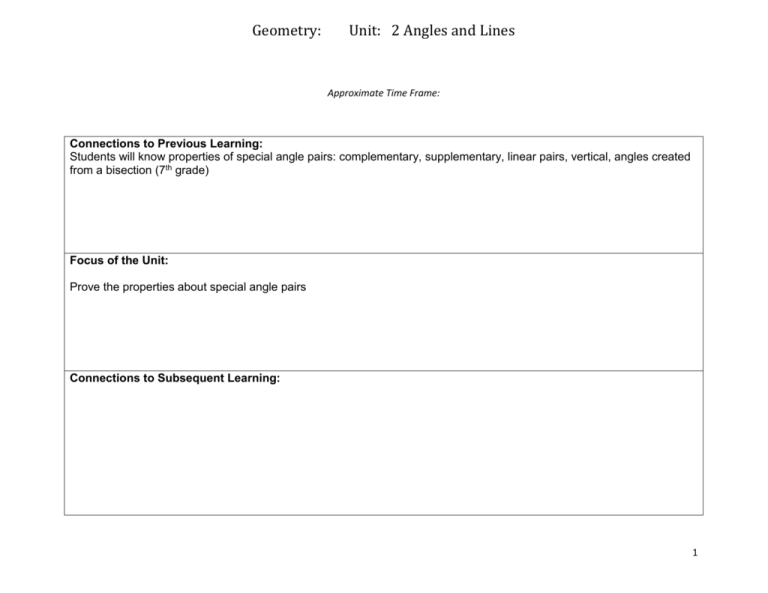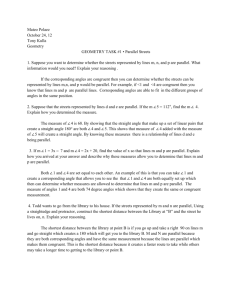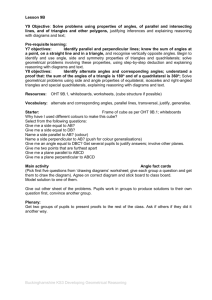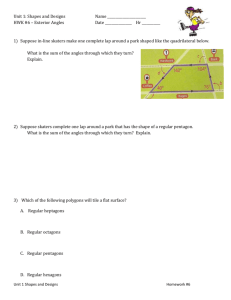Geometry: Unit: 2 Angles and Lines
advertisement

Geometry: Unit: 2 Angles and Lines Approximate Time Frame: Connections to Previous Learning: Students will know properties of special angle pairs: complementary, supplementary, linear pairs, vertical, angles created from a bisection (7th grade) Focus of the Unit: Prove the properties about special angle pairs Connections to Subsequent Learning: 1 Geometry: Unit: 2 Angles and Lines Desired Outcomes Standard(s): G-CO.9: Prove theorems about lines and angles. Theorems include: vertical angles are congruent; when a transversal crosses parallel lines, alternate interior angles are congruent and corresponding angles are congruent; points on a perpendicular bisector of a line segment are exactly those equidistant from the segment’s endpoints. Priority Standards Supporting Standards Additional Standards Transfer: Students will apply… Understandings: Students will understand that… Essential Questions: 2 Geometry: Unit: 2 Angles and Lines Highlighted Mathematical Practices: (Practices to be explicitly emphasized are indicated with an *.) 1. Make sense of problems and persevere in solving them. Students demonstrate their ability to persevere by selecting a modality to begin representing their understanding (i.e manipulatives, pictures). They can work collaboratively to represent their measurements or quantities and discuss their representations. 2. Reason abstractly and quantitatively. Students will demonstrate their abstract and quantitative reasoning by estimating lengths and then refining their estimates based upon new information. They also demonstrate reasoning by explaining indirect measurements. They need to use measurement units correctly – understanding that the smaller the unit, the more units you need to measure a given object. 3. Construct viable arguments and critique the reasoning of others. Students will explain why they chose to represent a quantity or measurement in a particular way. They will also listen to each other and explain what their peers have said. 4. Model with mathematics. In this unit, students are asked to transfer between manipulative, number line, drawings and other visual representations. They are asked to explain in words how their visuals are representing measurements or quantities. 5. Use appropriate tools strategically. Students demonstrate their ability to use non-standard measurement units to measure lengths of objects. Hey need to select the correct tools and know when a number line is an appropriate representation. 6. Attend to precision. Students demonstrate precision by using comparison language appropriately to describe their measurements and quantities. They count precisely to measure accurately. 7. Look for and make use of structure. Students demonstrate the ability to use structure in their graphs, ten frames and on the 120 chart. Students can use these structures to explain the patterns and answer questions about measurements and quantities. 8. Look for express regularity in repeated reasoning. When students note patterns on, and can use the 10 frames, 120 chart and graphs to solve problems or create new representations, they are using their repeated reasoning. 3 Geometry: Unit: 2 Angles and Lines Prerequisite Skills/Concepts: Advanced Skills/Concepts: Students should already be able to… Some students may be ready to… Knowledge: Students will know… Skills: Students will be able to… 4 Geometry: Unit: 2 Angles and Lines WIDA Standard: English Language Learners English language learners communicate information, ideas and concepts necessary for academic success in the content area of Mathematics. English language learners would benefit from: Academic Vocabulary: Critical Terms: Supplemental Terms: 5 Geometry: Unit: 2 Angles and Lines Assessment Pre-Assessments Formative Assessments Summative Assessments Self-Assessments Sample Lesson Sequence 6






